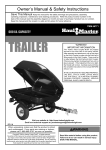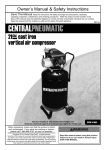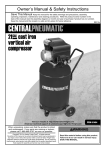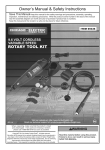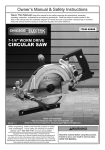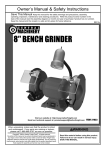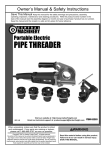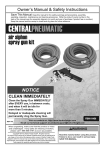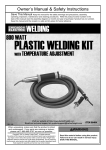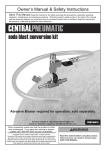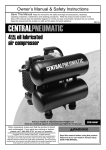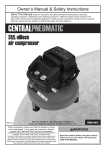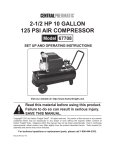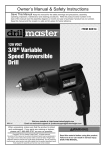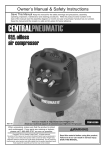Download Harbor Freight Tools 60 gal. 5 HP 165 PSI Two Stage Air Compressor Product manual
Transcript
Owner’s Manual & Safety Instructions Save This Manual Keep this manual for the safety warnings and precautions, assembly, operating, inspection, maintenance and cleaning procedures. Write the product’s serial number in the back of the manual near the assembly diagram (or month and year of purchase if product has no number). Keep this manual and the receipt in a safe and dry place for future reference. 60 GAL 5 HP 165 PSI oil lubricated air compressor REV 14i Visit our website at: http://www.harborfreight.com Email our technical support at: [email protected] When unpacking, make sure that the product is intact and undamaged. If any parts are missing or broken, please call 1-888-866-5797 as soon as possible. Copyright© 2014 by Harbor Freight Tools®. All rights reserved. No portion of this manual or any artwork contained herein may be reproduced in any shape or form without the express written consent of Harbor Freight Tools. Diagrams within this manual may not be drawn proportionally. Due to continuing improvements, actual product may differ slightly from the product described herein. Tools required for assembly and service may not be included. Read this material before using this product. Failure to do so can result in serious injury. SAVE THIS MANUAL. Table of Contents Safety��������������������������������������������������������� 2 Maintenancei���������������������������������������������� 14 Setupp���������������������������������������������������������� 6 Parts List and Diagram............................... 18 Specifications.............................................. 6 Warranty..................................................... 20 Safety Operationa��������������������������������������������������� 12 Setup WARNING SYMBOLS AND DEFINITIONS This is the safety alert symbol. It is used to alert you to potential personal injury hazards. Obey all safety messages that follow this symbol to avoid possible injury or death. Indicates a hazardous situation which, if not avoided, will result in death or serious injury. Indicates a hazardous situation which, if not avoided, could result in death or serious injury. Indicates a hazardous situation which, if not avoided, could result in minor or moderate injury. Operation Addresses practices not related to personal injury. Maintenance Page 2 For technical questions, please call 1-888-866-5797. Item 93274 IMPORTANT SAFETY INFORMATION WARNING Read all safety warnings and instructions. Failure to follow the warnings and instructions may result in electric shock, fire and/or serious injury. Save all warnings and instructions for future reference. The warnings, precautions, and instructions discussed in this instruction manual cannot cover all possible conditions and situations that may occur. It must be understood by the operator that common sense and caution are factors which cannot be built into this product, but must be supplied by the operator. c. Keep children and bystanders away from an operating compressor. 2. Electrical safety a. A qualified electrician must connect the compressor to a 240VAC/60Hz power supply, rated to at least 25 amps. b. Do not expose compressor to rain or wet conditions. Water entering a compressor will increase the risk of electric shock. 3. Personal safety a. Stay alert, watch what you are doing and use common sense when operating this compressor. Do not use this compressor while you are tired or under the influence of drugs, alcohol or medication. A moment of inattention while operating a compressor may result in serious personal injury. b. Use personal protective equipment. Always wear ANSI-approved eye protection during setup and use. c. Prevent unintentional starting. Ensure the switch is in the off‑position before connecting to power source or moving the compressor. 4. Compressor use and care c. Store an idle compressor out of the reach of children and do not allow persons unfamiliar with the compressor or these instructions to operate it. A compressor is dangerous in the hands of untrained users. d. Maintain the compressor. Keep the compressor clean for better and safer performance. Follow instructions for lubricating and changing accessories. Keep dry, clean and free from oil and grease. Check for misalignment or binding of moving parts, breakage of parts and any other condition that may affect the compressor’s operation. If damaged, have the compressor repaired before use. Many accidents are caused by a poorly maintained compressor. e. Use the compressor in accordance with these instructions, taking into account the working conditions and the work to be performed. Use of the compressor for operations different from those intended could result in a hazardous situation. 5. Service a. Have your compressor serviced by a qualified repair person using only identical replacement parts. This will ensure that the safety of the compressor is maintained. a. Do not use the compressor if the switch does not turn it on and off. Any compressor that cannot be controlled with the switch is dangerous and must be repaired. Item 93274 Setup b. Do not operate the Compressor in explosive atmospheres, such as in the presence of flammable liquids, gases or dust. Compressor motors produce sparks which may ignite the dust or fumes. Operation a. Keep work area clean and well lit. Cluttered or dark areas invite accidents. b. DISCONNECT and TAG OUT the compressor’s power source, turn the switch off, and relieve all air pressure before making any adjustments, changing accessories, or storing the compressor. Such preventive safety measures reduce the risk of starting the compressor accidentally. Maintenance 1. Work area safety Safety General Safety Warnings For technical questions, please call 1-888-866-5797. Page 3 Air Compressor Safety Warnings Safety 1. Risk of fire or explosion - do not spray flammable liquid in a confined area or towards a hot surface. Spray area must be well‑ventilated. Do not smoke while spraying or spray where spark or flame is present. Arcing parts - keep compressor at least 20 feet away from explosive vapors, such as when spraying with a spray gun. 2. Risk of bursting - do not adjust regulator higher than marked maximum pressure of attachment. 3. Risk of injury - do not direct air stream at people or animals. 4. Do not use to supply breathing air. 13. The use of accessories or attachments not recommended by the manufacturer may result in a risk of injury to persons. 14. All air line components, including hoses, pipe, connectors, filters, etc., must be rated for a minimum working pressure of 150 PSI, or 150% of the maximum system pressure, whichever is greater. 15. Industrial applications must follow OSHA guidelines. 16. Maintain labels and nameplates on the compressor. These carry important safety information. If unreadable or missing, contact Harbor Freight Tools for a replacement. Setup 5. Do not leave compressor unattended for an extended period while connected to power source. DISCONNECT and TAG OUT the compressor’s power source, turn the switch off, and relieve all air pressure after working. 17. This product is not a toy. Keep it out of reach of children. 6. Keep compressor well-ventilated. Do not cover compressor during use. 19. People with pacemakers should consult their physician(s) before use. Electromagnetic fields in close proximity to heart pacemaker could cause pacemaker interference or pacemaker failure. 7. Drain Tank daily and after use. Internal rust causes tank failure and explosion. 8. Add correct amount of compressor oil before first use and every use. Operating with low or no oil causes permanent damage and voids warranty. 9. Do not remove the valve cover or adjust internal components. Operation 10. Compressor head gets hot during operation. Do not touch it or allow children nearby during or immediately following operation. 11. Do not use the air hose to move the compressor. 12. Release the pressure in the storage tank before moving. 18. Operate unit on level surface. Check oil level daily and fill to marked level if needed. 20. WARNING: The brass components of this product contain lead, a chemical known to the State of California to cause cancer and birth defects or other reproductive harm. (California Health & Safety Code § 25249.5, et seq.) 21. WARNING: The cord of this product contains lead and/or di (2-ethylhexyl) phthalate (DEHP), chemicals known to the State of California to cause cancer, and birth defects or other reproductive harm. Wash hands after handling. (California Health & Safety Code § 25249.5, et seq.) 22. WARNING: This product contains or, when used, produces a chemical known to the State of California to cause cancer and birth defects or other reproductive harm. (California Health & Safety Code § 25249.5, et seq.) SAVE THESE INSTRUCTIONS. Maintenance Page 4 For technical questions, please call 1-888-866-5797. Item 93274 TO PREVENT ELECTRIC SHOCK AND DEATH FROM INCORRECT GROUNDING WIRE CONNECTION: A qualified electrician must connect the compressor to a 240VAC/60Hz power supply, rated to at least 25 amps. Do not use the compressor if the connector is damaged. If damaged, have it repaired by a service facility before use. Permanently Connected Compressors Safety Grounding This Compressor should be connected to a grounded metal permanent wiring system; or to a system having an equipment-grounding conductor. Symbology PSI Canadian Standards Association CFM Cubic Feet per Minute flow Underwriters Laboratories, Inc. SCFM Cubic Feet per Minute flow at standard conditions NPT National pipe thread, tapered NPS National pipe thread, straight V ~ A Setup Pounds per square inch of pressure Volts Alternating Current Amperes Maintenance Operation Double Insulated Item 93274 For technical questions, please call 1-888-866-5797. Page 5 Specifications Electrical Rating 240VAC / 60Hz / 22A Air Outlet Size 1/ ″ 2 Safety Air Pressure -18 NPT Shut-off 150 PSI Restart 125 PSI Air Tank Capacity 60 Gallons Air Production Capacity Sound Level 15.8 CFM @ 90 PSI 16.4 CFM @ 40 PSI 88 dB @ 3′ Oil Capacity 24 oz. Oil Type SAE 30W, non‑detergent, Air Compressor Oil (sold separately) Belt A53 V-Belt Setup Instructions for Putting Into Use Read the ENTIRE IMPORTANT SAFETY INFORMATION section at the beginning of this manual including all text under subheadings therein before set up or use of this product. TO PREVENT SERIOUS INJURY FROM AUTOMATIC OPERATION: Turn the Power Switch “OFF” and DISCONNECT and TAG OUT the compressor’s power source, turn the switch off, and relieve all air pressure before assembling or making any adjustments to the compressor. WARNING! A qualified electrician must connect the compressor to a 240VAC/60Hz power supply, rated to at least 25 amps. Operation Note: For additional information regarding the parts listed in the following pages, refer to the Assembly Diagram near the end of this manual. Wiring 1. A qualified electrician familiar with local electrical codes in your area must connect the compressor to a power supply. See Figure A: Power Supply. 2. WARNING! Electrical connections must be properly grounded. Ground connections should be connected at the grounding screw. Maintenance 3. WARNING! To reduce the risk of electrical hazards, fire hazards or damage to the compressor, use proper circuit protection. Your compressor is wired at the factory for operation using the voltage shown. Connect the compressor to a power source with the correct breaker size. Voltage 230V / 1 ph Full Load Amps 23 Breaker Size 40 amp Figure A: Power Supply Connect incoming power here 4. WARNING! Do not connect to prewired posts (i.e., the Motor). 5. CAUTION! Overheating, short circuiting and fire damage will result from inadequate wiring. Page 6 Grounding Screw Figure B For technical questions, please call 1-888-866-5797. Item 93274 Functions Air Filter Breather V-Belt Discharge Tube Safety Belt Guard Motor Oil Sight Glass Oil Drain Bolt Reset Button Setup Quick Coupler Tank Safety Valve Operation Wire Set Gauge Electrical Connection Maintenance Pressure Switch Drain Valve Item 93274 For technical questions, please call 1-888-866-5797. Page 7 Assembly/Mounting Safety 1. WARNING! To prevent serious injury and DEATH from tipping: Before use, bolt the compressor to the floor using bolts and vibration (rubber) pads (neither included). The floor surface must be hard, flat and level. Use shims to compensate for any slight unevenness of the floor. TO AVOID TANK DAMAGE, DO NOT OVERTIGHTEN BOLTS. 2. If not already attached, thread the Air Filter onto the side of the Cylinder Head. Checking the Oil 1. Check the oil level before operation. Fill the Pump Crankcase with SAE 30W, non‑detergent, Air Compressor Oil (sold separately). Setup IMPORTANT: Running the Air Compressor with no oil or low oil will cause damage to the equipment and void the warranty. 2. The oil level should be at the center of the “full” level on the Oil Sight Glass, as shown in Figure C. Add oil as needed to maintain this level. Do not let the oil level go below the center dot (LOW as shown above) and do not overfill the oil so that it is above the center dot (OVERFILL as shown above). 3. To add oil: a. Unthread the Breather. b. Using a funnel to avoid spills, pour enough oil into the Pump Crankcase to reach the “full” level in the Oil Sight Glass. c. Rethread the Breather. Note: SAE 30W, non‑detergent, Air Compressor Oil (sold separately) is recommended for use with this compressor. 4. If uncertain which oil to use for this compressor, call Harbor Freight Tools customer service at 1-888-866-5797 for assistance. 5. Change the compressor oil after the first hour of use to remove any debris. Operation CAUTION! TO PREVENT INJURY FROM BURNS: Do not add or change the oil while the compressor is in operation. Allow the compressor to cool before replacing oil. OVERFILL FULL LOW Figure C: Oil Sight Glass Maintenance Page 8 For technical questions, please call 1-888-866-5797. Item 93274 Breaking in the Compressor 2. Reconnect the compressor’s power source. 3. Turn the Power Switch ON. 4. Let the unit run for 30 minutes. Air will expel freely through the Coupler. 5. Turn the Power Switch OFF. Safety 1. DISCONNECT and TAG OUT the compressor’s power source, turn the switch off, and relieve all air pressure before inserting a male coupler (sold separately) into the female Quick Coupler. Fully open all regulators and valves. 6. DISCONNECT and TAG OUT the compressor’s power source, turn the switch off, and relieve all air pressure. 7. Remove the male coupler. Air Connection Setup Maintenance Operation Note: An in-line shutoff ball valve is an important safety device because it controls the air supply even if the air hose is ruptured. The shutoff valve should be a ball valve because it can be closed quickly. 2. Depending on the tool that will be used with this compressor, incorporate additional components, such as an in-line oiler, a filter, or a dryer (all sold separately), as shown on Figure D on page 10 and Figure E on page 11. Consult air tool’s manual for needed accessories. Setup 1. Connect a regulator valve, an inline shut off valve and a 1/4″ NPT air hose to the Quick Coupler (all sold separately). The air hose must be long enough to reach the work area with enough extra length to allow free movement while working. Item 93274 For technical questions, please call 1-888-866-5797. Page 9 Description Non-lubricated Tools A Air Hose Filter Regulator Lubricator (optional) Coupler and Plug Leader Hose (optional) Air Cleaner / Dryer (optional) Air Adjusting Valve (optional) Maintenance A B C D E F G H Operation Lubricated Tools B B C C A Function A E F H Connects air to tool Prevents dirt and condensation from damaging tool or workpiece Adjusts air pressure to tool For air tool lubrication Provides quick connection and release Increases coupler life Prevents water vapor from damaging workpiece For fine tuning airflow at tool G D E Setup Figure D: Portable Air Supply Setup Safety Page 10 For technical questions, please call 1-888-866-5797. Item 93274 Item 93274 For technical questions, please call 1-888-866-5797. Page 11 A B C D E F G H I J K L M N O F Description F E I I J K N Operation J H Setup Function H L L M O Safety For noise and vibration reduction Secures air compressor in place Isolates sections of system for maintenance For vibration reduction Distributes air to branch lines To drain moisture from system Brings air to point of use Connects air to tool Prevents dirt and condensation from damaging tool or workpiece Adjusts air pressure to tool For air tool lubrication Provides quick connection and release Increases coupler life Prevents water vapor from damaging workpiece For fine tuning airflow at tool Non-lubricated Tools C C Vibration Pads Anchor Bolts Ball Valve Isolation Hose Main Air Line - 3/4″ minimum recommended Ball Valve Branch Air Line -1/2″ minimum recommended Air Hose Filter Regulator Lubricator (optional) Coupler and Plug Leader Hose (optional) Air Cleaner / Dryer (optional) Air Adjusting Valve (optional) B A Maintenance B A C D G Lubricated Tools Slope Figure E: Stationary Air Supply Setup F Operating Instructions Read the ENTIRE IMPORTANT SAFETY INFORMATION section at the beginning of this manual including all text under subheadings therein before set up or use of this product. Safety Compressor Area Set Up 1. Designate a work area that is clean and well‑lit. The work area must not allow access by children or pets to prevent injury. 2. Locate the Compressor on a flat level surface to ensure proper pump lubrication and to prevent damage to the unit. Keep at least 12″ of space around the unit to allow air circulation. 3. Route the connection to the power supply from the compressor to the grounded wall outlet, along a safe path without creating a tripping hazard or exposing the connector to possible damage. General Operation 1. Close the Moisture Drain. Setup 2. Check for oil leaks and check the oil level (See Checking the Oil). 3. Close the in-line Shutoff Valve between the compressor and the air hose. 4. Run compressor on power supply (240 VAC/60H). 5. Turn the Power Switch ON. 6. Allow the Air Compressor to build up pressure until it cycles off. Operation Note: At the beginning of the day’s first use of the Air Compressor, check for air leaks by applying soapy water to connections while the Air Compressor is pumping and after pressure cutout. Look for air bubbles. If air bubbles are present at connections, tighten connections. Do not use the Air Compressor unless all connections are air tight, the extra air leaking out will cause the compressor to operate too often, increasing wear on the compressor. Note: As long as the Power Switch is ON, the operation of the Air Compressor is automatic, controlled by an internal pressure switch. The Compressor will turn on automatically when the air pressure drops to 125 PSI, and will turn off automatically when the air pressure reaches 150 PSI. WARNING! TO PREVENT SERIOUS INJURY AND DEATH FROM EXPLOSION: Do not adjust the internal pressure switch. Any change to the automatic pressure levels may cause excess pressure to accumulate, causing a hazardous situation. 7. Adjust the regulator knob so that the air output is enough to properly power the tool, but the output will not exceed the tool’s maximum air pressure at any time. Turn the knob clockwise to increase the pressure and counter-clockwise to decrease pressure. Adjust the pressure gradually, while checking the air output gauge to set the pressure. 8. Make sure the air tool’s throttle or switch is in the off position. Connect the air tool to the air hose. 9. Open the in-line Shutoff Valve. 10. Use the air tool as needed. 11. After the job is complete, turn the Power Switch OFF. 12. Close the in-line Shutoff Valve. 13. DISCONNECT and TAG OUT the compressor’s power source, turn the switch off, and relieve all air pressure. Maintenance 14. Turn the Moisture Drain, at the bottom of the Tank, two turns to release any built‑up moisture and the internal tank pressure. Close the Drain after moisture has drained out. Do not remove the Moisture Drain. 15. Clean, then store the Air Compressor indoors. Page 12 For technical questions, please call 1-888-866-5797. Item 93274 Emergency Depressurization Safety If it is necessary to quickly depressurize the Compressor, turn the Power Switch OFF. Then, pull on the ring on the Safety Valve to quickly release stored air pressure. Figure F: Safety Valve Automatic Shut off System b. Wait until the Compressor cools down (about 10 minutes); c. If the unit does not start up again on its own, press the Reset Button to start the compressor; Reset Button 2. Possible causes of repeated automatic shut off of the compressor are: a. An air leak or open hose causing the compressor to cycle too often and build up heat. Setup a. Shut off all tools. d. Resume operation. 3. Correct any issues before further use to avoid damage to the compressor. Operation 1. If the Compressor automatically shuts off before reaching its normal cutoff pressure: Maintenance Figure G: Reset Button Item 93274 For technical questions, please call 1-888-866-5797. Page 13 Maintenance and Servicing Procedures not specifically explained in this manual must be performed only by a qualified technician. Safety TO PREVENT SERIOUS INJURY FROM AUTOMATIC OPERATION: Turn the Power Switch “OFF” and DISCONNECT and TAG OUT the compressor’s power source, turn the switch off, and relieve all air pressure before performing any inspection, maintenance, or cleaning procedures. TO PREVENT SERIOUS INJURY FROM COMPRESSOR FAILURE: Do not use damaged equipment. If abnormal noise or vibration occurs, have the problem corrected before further use. Cleaning, Maintenance, and Lubrication Setup 1. BEFORE EACH USE, inspect the general condition of the air compressor. Check for: • loose hardware, • misalignment or binding of moving parts, • damaged belts, • cracked or broken parts, • damaged electrical wiring, and • any other condition that may affect its safe operation. 2. AFTER USE, wipe external surfaces of the compressor with a clean cloth. 3. WARNING! If the connection to the power supply of this compressor is damaged, it must be replaced only by a qualified service technician. Maintenance Schedule Following are general guidelines for maintenance checks of the Air Compressor. Operation Note: The environment in which the compressor is used, and the frequency of use will affect how often you will need to check the Air Compressor components and perform maintenance procedures. Daily: a. Check oil level. b. Check for oil leaks. c. Make sure all nuts and bolts are tight. d. Drain moisture from air tank. e. Check for abnormal noise or vibration. f. Check for air leaks.* g. Inspect belt. h. Wipe off any oil or dirt from the compressor.** Weekly: a. Inspect Air Filter. b. Inspect Breather. Monthly: a. Inspect Safety Valve. b. Check belt adjustment. Every 6 months or 100 Operation Hours: Replace Pump oil.*** * To check for air leaks, apply soapy water to joints while the Air Compressor is pressurized. Look for air bubbles. Maintenance ** To clean the compressor surface, wipe with a damp cloth, using a mild detergent or mild solvent. *** Use SAE 30W, non‑detergent, Air Compressor Oil only (sold separately). Draining Moisture from the Tank The Moisture Drain is located under the Tank. It must be used daily to release all trapped air and moisture from the Tank. Doing this will eliminate condensation and prevent tank corrosion. 1. DISCONNECT and TAG OUT the compressor’s power source, turn the switch off, and relieve all air pressure. 2. Place a collection pan under the Moisture Drain. Page 14 3. Open the Moisture Drain two or three turns ONLY. 4. When all the pressure and moisture is released, close the Moisture Drain. For technical questions, please call 1-888-866-5797. Item 93274 Oil Maintenance CAUTION! TO PREVENT INJURY FROM BURNS: Allow Air Compressor to cool before changing the oil. 1. Place a container under the Oil Drain Bolt. 5. Fill the Pump with new SAE 30W, non‑detergent, Air Compressor Oil to the FULL level on the Oil Sight Glass (24 oz.). 2. Unthread the Breather to allow air flow into the Pump. Safety Check the oil periodically for clarity. Replace oil if it appears milky or if debris is present, or every 6 months, or 100 operation hours, whichever comes first. Replace the oil more frequently if compressor is used in harsh environments such as high heat or high humidity. 6. Rethread and tighten the Breather. 3. Remove the Oil Drain Bolt, allowing the oil to drain into the container. 4. When the oil is completely drained from the Pump, replace the Oil Drain Bolt. 7. Discard the old oil according to local, state and federal regulations. Air Filter Maintenance 1. Remove the Cover. 3. Replace with a new Air Filter. 2. Remove the Air Filter. 4. Replace the Cover. Setup Check the Air Filter weekly to see if it needs replacement. Replace the filter more often if compressor is used in dirty environments. Replacing the V-Belt 1. Unlatch the fasteners and open the guard. 3. Check and adjust belt tension according to the steps below: Deflection Distance Operation TO PREVENT SERIOUS INJURY FROM AUTOMATIC OPERATION: DISCONNECT and TAG OUT the compressor’s power source, turn the switch off, and relieve all air pressure before opening the Belt Guard. d. Move the motor away from the other pulley until it is properly tensioned according to the directions below. Tighten the motor mounting bolts. Fasteners Fan a. Press on the center of the longest span on the belt with moderate finger pressure. Then measure the deflection distance, the distance that the belt moved. The belt should deflect about 1/2″. Pulley Figure H Bolts 2. Examine belt for cracks, tears in the backing, or other damage. Replace belt if damaged according to steps below: a. Loosen the motor mounting bolts and slide the motor towards the other pulley as far as possible. b. Slide the old belt off of the smallest pulley first, then remove it. c. Put the new belt around the larger pulley first, then around the smaller pulley. Item 93274 b. If the belt deflects too much, tighten belt by loosening the motor mounting bolts and moving the motor away from the other pulley slightly. Secure motor mounting bolts and retest tension. If the belt is too long to be properly tensioned, it must be replaced. c. If the belt deflects too little, loosen belt by loosening the motor mounting bolts and moving the motor towards the other pulley very slightly. Secure motor mounting bolts and retest tension. 4. Before use, replace belt cover. For technical questions, please call 1-888-866-5797. Page 15 Maintenance V-Belt Tank Inspection Safety 1. Follow local, state, and national air tank maintenance and inspection codes. 3. Yearly, the tank must be visually inspected by a qualified inspector. 2. The head and shell minimum allowable wall thicknesses for these inspections are both 0.094" each. 4. Every 10 years, the tank must be hydrostatically inspected by a qualified inspector. Troubleshooting Problem Compressor does not start or restart Setup Compressor builds pressure too slowly Operation Compressor not building enough air pressure Overheating Possible Causes Likely Solutions 1. Tank(s) already pressurized. 1. No problem. Compressor will start when needed. 2. Power supply not connected properly. 2. Check that connection is secure. 3. Incorrect power supply. 3. Check that circuit matches compressor requirements. 4. No power at outlet. 4. Reset circuit breaker, or have outlet serviced by a qualified technician. 5. Thermal overload switch tripped. 5. Turn off Compressor and wait for it to cool down. Press reset button. Resume operation. 6. Building power supply circuit tripped or blown fuse. 6. Reset circuit or replace fuse. Check for low voltage conditions. It may be necessary to disconnect other electrical appliances from the circuit or move the compressor to its own circuit. 7. Compressor needs service. 7. Have unit inspected by a qualified technician. 1. Incorrect power supply. 1. Check that circuit matches compressor requirements. 2. Crankcase oil overfilled or oil too thick. 2. Drain oil and refill to proper level with recommended oil. 3. Working environment too cold. 3. Move compressor to a warmer location. Check that recommended oil is in crankcase. 4. Safety valve leaking. 4. Listen for air leaking from valve. If leaking, replace with identical valve with same rating. DO NOT SEAL OR TAMPER WITH SAFETY VALVE. 5. Loose fittings. 5. Reduce air pressure, then check all fittings with a soap solution for air leaks and tighten as needed. Do not overtighten. 1. Air filters need cleaning/replacing. 1. Check inlet and outlet filters. Clean and/or replace as needed. 2. Check Valve needs service. 2. Have technician clean or replace, as needed. 3. Compressor not large enough for job. 3. Check if accessory CFM is met by Compressor. If Compressor cannot supply enough air flow (CFM), you need a larger Compressor. 4. Loose fittings. 4. Reduce air pressure, then check all fittings with a soap solution for air leaks and tighten as needed. Do not overtighten. 5. Hose or hose connections too narrow. 5. Replace with wider hose and/or hose connections. 6. Crankcase oil too thick. 6. Drain oil and refill to proper level with recommended oil. 7. High altitude reducing air output. 7. Higher altitudes require compressors with greater output. 1. Air filters need cleaning/replacing. 1. Check inlet and outlet filters. Clean and/or replace as needed. Maintenance 2. Crankcase oil too thin or incorrect type. 2. Drain oil and refill to proper level with recommended oil. 3. Crankcase oil level too low. 3. Add oil to proper level, check for leaks. 4. Unusually dusty environment. 4. Clean and/or replace filters more often or move unit to cleaner environment. 5. Unit not on level surface. 5. Reposition unit on a level surface. Follow all safety precautions whenever diagnosing or servicing the compressor. Disconnect power supply before service. Page 16 For technical questions, please call 1-888-866-5797. Item 93274 Troubleshooting (cont.) Likely Solutions 1. Loose fittings. 1. Reduce air pressure, then check all fittings with a soap solution for air leaks and tighten as needed. Do not overtighten. 2. Compressor not large enough for job. 2. Check if accessory CFM is met by Compressor. If Compressor doesn’t reach accessory CFM, you need a larger Compressor. 1. Loose fittings. 1. Reduce air pressure, then check all fittings with a soap solution for air leaks and tighten as needed. Do not overtighten. 2. Loose or damaged belt guard. 2. Replace belt guard. 3. Crankcase overfilled with oil or oil is incorrect thickness or type. 3. Drain oil and refill to proper level with recommended oil. 4. Crankcase oil level too low. 4. Add oil to proper level, check for leaks. 5. Unit not on level surface. 5. Reposition unit on a level surface. Moisture in discharge air Too much moisture in air. Install inline air filter/dryer, and/or relocate to less humid environment. Safety Valve “pops” Safety valve needs service. Pull on test ring of safety valve. If it still pops, replace. Air leaks from pump or fittings Loose fittings. Reduce air pressure, then check all fittings with a soap solution for air leaks and tighten as needed. Do not overtighten. Air leaks from tank Defective or rusted tank. Have tank replaced by a qualified technician. Drain moisture from tank daily to prevent future corrosion. Oil in discharge air or high oil consumption 1. Crankcase oil too thin or crankcase overfilled with oil. 1. Drain oil and refill to proper level with recommended oil. 2. Unit not on level surface. 2. Reposition unit on a level surface. 3. Crankcase vent clogged. 3. Clean Crankcase vent. Compressor starts and stops excessively Excessive noise Safety Possible Causes Setup Problem Maintenance Operation Follow all safety precautions whenever diagnosing or servicing the compressor. Disconnect power supply before service. Item 93274 For technical questions, please call 1-888-866-5797. Page 17 Parts List and Diagram PLEASE READ THE FOLLOWING CAREFULLY Safety THE MANUFACTURER AND/OR DISTRIBUTOR HAS PROVIDED THE PARTS LIST AND ASSEMBLY DIAGRAM IN THIS MANUAL AS A REFERENCE TOOL ONLY. NEITHER THE MANUFACTURER OR DISTRIBUTOR MAKES ANY REPRESENTATION OR WARRANTY OF ANY KIND TO THE BUYER THAT HE OR SHE IS QUALIFIED TO MAKE ANY REPAIRS TO THE PRODUCT, OR THAT HE OR SHE IS QUALIFIED TO REPLACE ANY PARTS OF THE PRODUCT. IN FACT, THE MANUFACTURER AND/OR DISTRIBUTOR EXPRESSLY STATES THAT ALL REPAIRS AND PARTS REPLACEMENTS SHOULD BE UNDERTAKEN BY CERTIFIED AND LICENSED TECHNICIANS, AND NOT BY THE BUYER. THE BUYER ASSUMES ALL RISK AND LIABILITY ARISING OUT OF HIS OR HER REPAIRS TO THE ORIGINAL PRODUCT OR REPLACEMENT PARTS THERETO, OR ARISING OUT OF HIS OR HER INSTALLATION OF REPLACEMENT PARTS THERETO. Parts List Part Setup Operation 1 2 3 4 5 6 7 8 9 10 11 12 13 14 15 16 17 Description Tank: 60 Gallon Black 3 Leg Sheave: 4.25″ Od, 2 Groove Bushing: 7/8″ H Check Valve: 1/2″ X 1/2″, Drain Valve: 1/4″, Vs, Knurled Safety Valve: 170 Psi 3/8″ Romex Connector Bushing: Hex 1/2″ X 1/4″ Gauge: 300 Psi Compressor Belt Guard: Back W/ Cut Outs Belt Guard: Front Motor: 5Hp 1Ph 230V Discharge Tube: Copper, 5/8″ Od Elbow: 5/8″ Tube X 1/2″ Npt Bracket: Belt Guard Belt: A53 Qty 1 1 1 1 1 1 1 1 1 1 1 1 1 1 2 1 1 Part 18 19 20 21 22 23 24 25 26 27 28 29 30 31 32 33 34 Description Nipple: 1/4″ Close Pressure Switch: 130-165 Psi Nipple: 1/2″ Close Coupling-Pipe: 1/2″Npt Plug: 1/4″, Allen Head Fastener: Belt Guard Sq. Hd Bolt: 1/4″-20X 3/4″L Hex Hd Bolt: 1/4″-20 X 3/4″L, Tap-Tight Washer-Flat: Fender, 1 1/4″ Nut: 1/4″-20 Nylon Lock Bolt: 5/16″-18 X 1″L Hex Hd Washer-Flat: 5/16″ Nut: 5/16″ Nylon Lock Wire-Set: 33″ 12/3 So Bolt: 5/16″-18 X 2″L Tubing: 1/4″ Od X Ft Connector: Push-In, 1/2″ Qty 1 1 1 1 1 7 1 4 4 1 4 16 8 1 4 1 1 Maintenance Record Product’s Serial Number Here: Note: If product has no serial number, record month and year of purchase instead. Note: Some parts are listed and shown for illustration purposes only, and are not available individually as replacement parts. Page 18 For technical questions, please call 1-888-866-5797. Item 93274 Safety Assembly Diagram 12 11 17 10 23 32 Setup 29 2 15 3 14 25 26 29 28 30 16 7 24 25 6 13 15 19 31 9 21 20 4 18 8 33 22 Operation 26 27 34 29 29 30 1 Item 93274 For technical questions, please call 1-888-866-5797. Maintenance 5 Page 19 Limited 90 Day Warranty Harbor Freight Tools Co. makes every effort to assure that its products meet high quality and durability standards, and warrants to the original purchaser that this product is free from defects in materials and workmanship for the period of 90 days from the date of purchase. This warranty does not apply to damage due directly or indirectly, to misuse, abuse, negligence or accidents, repairs or alterations outside our facilities, criminal activity, improper installation, normal wear and tear, or to lack of maintenance. We shall in no event be liable for death, injuries to persons or property, or for incidental, contingent, special or consequential damages arising from the use of our product. Some states do not allow the exclusion or limitation of incidental or consequential damages, so the above limitation of exclusion may not apply to you. THIS WARRANTY IS EXPRESSLY IN LIEU OF ALL OTHER WARRANTIES, EXPRESS OR IMPLIED, INCLUDING THE WARRANTIES OF MERCHANTABILITY AND FITNESS. To take advantage of this warranty, the product or part must be returned to us with transportation charges prepaid. Proof of purchase date and an explanation of the complaint must accompany the merchandise. If our inspection verifies the defect, we will either repair or replace the product at our election or we may elect to refund the purchase price if we cannot readily and quickly provide you with a replacement. We will return repaired products at our expense, but if we determine there is no defect, or that the defect resulted from causes not within the scope of our warranty, then you must bear the cost of returning the product. This warranty gives you specific legal rights and you may also have other rights which vary from state to state. 3491 Mission Oaks Blvd. • PO Box 6009 • Camarillo, CA 93011 • 1-888-866-5797




















